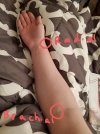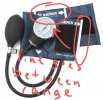My first set of vital signs on almost every call, even "critical calls", is manual. The only time I don't do it is cardiac arrest. That's my county's protocol and it is just a part of my routine. Personally, I think Lifepak 15 are garbage at getting vital signs so my manual heart rate and blood pressure will be the most accurate. It may be the coiled blood pressure cuff tubing? Then the pulse ox always struggles to work "Poor perfusion! Poor perfusion!" even when I crank it up to high sensitivity. Ugh. I think the only time that darn machine doesn't give me a bizarre number like 202/186 (it really is dumb and give me phony bologna numbers like that) is when the patient has coded... Then it'll be 120/80, your dead patient is OK. Kinda reminds me of The House of God law XII. "If the radiology resident and the medical student both see a lesion on the chest x-ray, there can be no lesion there." (
https://en.m.wikipedia.org/wiki/The_House_of_God) Just switch it up to "If the Lifepak 15 can get a normal blood pressure and the experienced paramedic/firefighter can palpate a carotid pulse, there can be no pulse." Something like that, haha. Same thing with Philip MRx monitor, RBBB, and STEMI, haha. Dunno why, but MRx always thought normal RBBB was a STEMI and would frequently miss the STEMI/proximal LAD occlusion with RBBB, Hahaha.
Anyways, it's rare I cannot get a blood pressure. So rare that I usually use the blood pressure to auscultate the heart rate instead of palpate. I find it easier to auscultate a blood pressure instead of palpate a pulse. I usually inflate the cuff, listen on the way up to know when it goes away (that is my systolic), then deflate the cuff slowly (you'll hear the systolic again), and usually 10-20 mm Hg below systolic, when the Korotkoff sound is loudest, I stop bleeding air out. I count the heart rate I hear for 15 seconds (or 6 seconds if the heart is really fast multiply by 10 or "perfect 1 beat per second" then I just insta say 60 bpm without listening more), then deflate more to get diastolic. I actually do count respirations and notice people do miss brady/tachypnea a lot because patients will not appear dyspneic, but have abnormal rates, especially now with COVID 19. I am pretending to still get your blood pressure, stethoscope in my ear, cuff on, and count your respiration pretending to get your blood pressure still. I used to test students on vital signs, and when I was a student myself, I got tested on vital signs. Auscultating the heart rate during the blood pressure was my method of confirming my heart rate, and eventually, I just ditched palpating the pulse rate while working in the field because of how easy it is for me to auscultate and get all my vitals while "auscultating the blood pressure".
I think people get psyched when patients are hypotensive, but it shouldn't really be quieter or harder to get, but rather just lower mm Hg than usual when you do finally hear it. I think people just give up when they don't heart it at <90 mm Hg, but it is still there and probably easier than getting a palpated pulse. Like it'll still be loud enough to hear even if the blood pressure 60/40 or something crazy low. I don't find any association between loudness and how high/low blood pressure is, which it seems people do, but I think that is a mental thing. They are used to hearing the sound go away at 90, 80, 70 mm Hg (their diastolic) when now a hypotensive patient systolic is 90, 80, 70... mm Hg and they think since they normally lose the sound there that it is hard to hear or expect to lose it there, but they shouldn't. I think it's a mental thing personally. I've heard soft Korotkoff sounds at 180 mm Hg on hypertensive patients and noticeable/louder Korotkoff sounds at 80 mm Hg on hypotensive patients. That's my personal experience with doing a manual blood pressure almost every single call for a decade (only for 1 year, I didn't take manual vital signs, and that is because I was an EMT on an ALS 911 unit where
ambulance drivers I mean EMTs weren't allowed to tech calls :/).
I prefer auscultating the heart sound than palpating a pulse, if I cannot get it via when I get a blood pressure. I find it easier to palpate a brachial pulse than radial or carotid. I do not find carotid/femoral pulse easy or reliable at all. Maybe it is just me, but carotid/femoral sucks even in healthy patients in my opinion. I think my sense of feeling is extremely poor. I do not like palpated blood pressures at all. I can do brachial no problem. Radial, dorsalis pedis, and posterior tibialis harder. For CMS (or whatever variation you use eg PSM, CSM, CMSTP), if I cannot palpate dorsalis pedis or posterior tibialis, cap refill or warmth is an alternative I document. I'll sometimes try using a pulse ox pleth wave as an alternative (especially in restrained patients, proof I feel the restraint had good circulation/wasn't too tight). Popliteal is difficult as well, and counterinuitively easier to do with the knee flexed/bent.
Personally, stethoscopes don't make a difference for me and I am practically deaf I feel like. I kept losing/breaking my fancy stethoscopes at work so I used the cheap toy ones provided at work. When I decided to make heart sounds/tone routine for me, I got a fancy stethoscope again, but it isn't necessary. One of my previous EMTs said he noticed a difference, but I don't.
I guess my advice is to put the blood pressure cuff high up on the arm, not so low that the bottom part is touching the antecubital (inner elbow where IVs are usually started). I make sure it is snug on the patient, somewhat tight like how tight I'd velcro shoes on or tie shoe laces on my shoes. Should be snug. For accuracy sake, make sure the cuff is the right size (white line should go between the limit on the cuff, there is like a range printed on the cuff and a white line that should go betweem the printed range... most people don't notice it). For accuracy sake, make sure the artery line on the blood pressure cuff (I think it is the middle of the bladder that inflates when you take a blood pressure) is over where I'd palpate the brachial pulse.
I do not tuck my stethoscope under my blood pressure cuff, which I see a lot of people do.
With cheapo stethoscopes, the bell (small side that people think is for pediatric patients) usually is better at getting low frequency sounds like blood pressures and heart tones, in theory I guess, and the diaphragm (big side people think is for adults, the side most people use) is better for high frequency sounds like breath sounds. I personally don't notice a difference, but maybe it'll give you the edge you need, if you use a cheapo. Littman doesn't care which side you use, but how hard you press. Lightly apply the stethoscope for low frequency and more pressure for higher frequency. Most common issue is people pressing up their stethoscope too much into the patient's skin thinking it'll help them when it does the opposite.
Location for me matters somewhat. The brachial, which is easier for me to palpate than the radial or carotid (I do not palpate mid shaft humerus, but at the antecubital, look at the picture attached) is more medial. I have the elblow completely extended and hand supinated (facing up towards the sky) when I auscultate blood pressures or palpate brachial pulses. To help keep the hand supinated on uncooperative patients, I'll usually put my elbow (with a chuck folded between my elbow and the patient's hand) in the palm of the patient's hand and hold it down that way, if I can. For me, having the hand supinated makes it eaiser to auscultate the blood pressure and palpate the brachial personally and I consider it an important step for me, but not absolutely necessary, just easier. I just put the bell/diaphragm of the stethoscope directly over where I'd palpate the brachial pulse (look at picture attached) and again not tucked under the blood pressure cuff. The brachial pulse is usually located in the same spot you'd visually see veins to put an IV in so that can be a quick easy way to find the right location to palpate and auscultate, if you can see the veins (like you can see in the picture attached, my vein is very visible since I am see through like a ghost, haha).
In a moving ambulance, I usually rest my feet on the side of the gurney or under carriage, and the patient's arm on a chuck resting on my lap (I cannot believe how many people take blood pressures without chucks, gross!). I find that helps eliminate most of the sound of the moving ambulance. Probably my leg, being fatty/muscular, eliminating most of the vibration of the ambulance.
I'm sure with time, it'll click. Personally, as a medic, I only trust me and my best friend (my EMT partner for like 4 years now?) with manual vitals/blood pressures. I imagine most medics who listen to EMT vital signs are just being nice, but usually somewhat hesitant to believe it or don't care. For me, even though I do manuals and only trust me and my best friend, vitals are usually just something I check off in my to do list rather than something I really care about. I work in an area where paramedics are practically EMTs, very limited scope, so the only meds that matter with blood pressure is Nitroglycerin and Morphine (for me, Morphine causing hypotension is over dramatized/overstated, and I am very lenient with giving Morphine... I cannot think of a time I've seen hypotension due to Morphine and even borderline hypotensive patients still tolerate it well, in my experience). My protocol cares about blood pressure for Nitro and Morphine (and TXA, they have to have SBP <90 mm Hg for us to give it, I've yet to give it) nothing else. Otherwise vital signs are like quantative findings, something to check off my list of things I am suppose to do, look busy, rather than life or death treatment stuff for me. So don't be too stressed out about vital signs.



